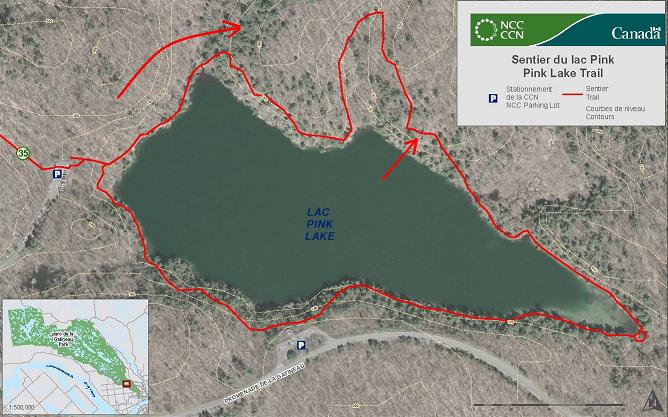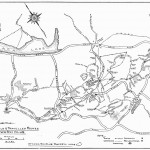Pink Lake is one of the most popular sites in Gatineau Park and has been for a long time.
This may be because it is one of the first parking areas you come to going up the parkway, but it’s certainly worth the stop.
Although there is something pink about the lake, it takes its name from a family of settlers who arrived from Ireland in the 1820s and tried to eke out a living farming these rocks.
James Pink was first to break the ground and was part of a family that included brothers Charles and Samuel and in-laws the Moffatts. There are still a dozen families named Pink listed in the phone book and several dozen named Moffatt.
What is pink lies unseen 13 meters below the surface.
As the interpretive signs along the trail explain, Pink Lake lies in a notch deep enough that the wind isn’t strong enough to mix its waters all the way to the bottom.
That means that a layer of cold, dense, deoxygenated water lies at the bottom of the lake.
Water with no oxygen usually means water with no life. But in the case of Pink Lake there is a breed of bacteria that lives in a thick layer at the top of this deoxygenated water and that layer—though no one ever sees it—is pink.
Decades after James Pink arrived in the area there was mining at Pink Lake but in the early 1900s people from Ottawa began using the Gatineau Hills for skiing.
One of the earliest Ottawa Ski Club trails passed Pink Lake on its way up to Kingsmere. Note on this 1957 map the trail crossing Kingsmere Lake says “To Pink Lake Lodge”
Skiers often partied or spent the night at Kingsmere at a farmhouse that had been converted into a hotel known alternately as Murphy’s or Wattsford’s; after William Murphy (who was the farmer) and later after Gerald Wattsford (an army General who turned the place into a country club).
By 1920 skiing this route was popular enough that the Ottawa Ski Club built a ski lodge at Pink Lake described as “roomy” with a stove.
It was located on the hill just north and west of Pink Lake with a southern exposure overlooking the lake. Click here to see a map of where it was located.
It survived there, and was expanded twice before it was uprooted and moved to become Cassel Lodge at Camp Fortune in the 1960s.
Its name came from the most recent renovator Elmer Cassel who was a teacher in Ottawa at Glashan School. This is the building that’s almost under the chairlift running up Pineault and now sports a sign that says “The Play Pit.”
During the summer Pink Lake was popular too. It was one of the closest lakes to Ottawa and attracted swimmers and nighttime partiers. There are even tales of crowds of rowdy youths chasing off police sent up to Pink Lake to quiet things down.
Even worse than the garbage that people were dropping into the lake all that action was scuffing the thin layer of vegetation off the rocks and every time it rained the rocks were leaching phosphorus that fed algae and made the lake a lovely blue-green that would eventually kill everything that still survived in the upper oxygenated water.
So in 1988 Gatineau Park closed Pink Lake.
The trail you can walk now and the interpretive signs were put in at that time.

That’s also when Gatineau Park officials realized how unique Pink Lake was. There are species of fish in Pink Lake that exist nowhere else. They descended from salt-water fish that got trapped in Pink Lake as the Champlain Sea was receding after the last ice age thousands of years ago.
The trail around Pink Lake is hikable by anyone who’s able-bodied but it does involve a bit of stair climbing. Lots of trail runners use this loop for a workout.
Moving clockwise the trail weaves up and down the steep sides to the north of the lake then skirts at water level around the east end.
On a day that I visited I saw turtles and also a snake warming itself on the rocks.
The same deep notch that keeps wind from stirring the water forces you once more to climb stairs that take the trail right under the lookout accessible from the first parking lot.
Overall you’ll be walking 2.3 kilometers and climbing 20 or 25 metres four times.



Nice perspective on Pink’s Lake often missed by tourists. I am a direct descendant of the Moffatts that settled the area and eventually took up lands in the Nepean area. My grandmother would
be proud.
My grandparents were Moffatt’s (George and Mabel (nee Smith-Pink)) who settled on the Rideau River as dairy farmers. I don’t know too much of the family history, but would be interested in knowing more about the Pinks or Moffatts.
This is wonderful information on Pink Lake. We lived in Cantley until 2003 and Pink Lake was one of our favorite places to visit. My daughter want to do a biology paper on the lake for her High School course can you guide me to other sources of information on the lake? Boy to I miss it in the fall. South Carolina has its charms but it sure isn’t Gatineau in the fall!